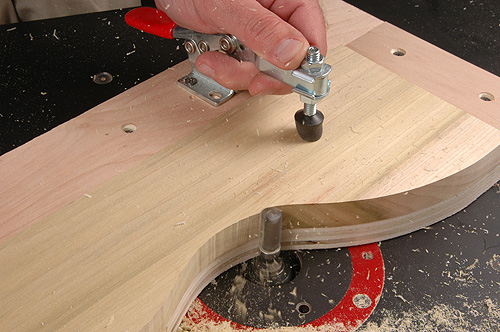How can I use smaller templates on a table router without it grabbing the wood, or my fingers?
- Greg
Breckenridge, MN
How can I use smaller templates on a table router without it grabbing the wood, or my fingers?
- Greg
Breckenridge, MN
Our Expert
 Routing with a guide template is one of the fastest and most accurate methods for creating multiple parts. As the guide bearing follows the template, the bit creates the shape
Routing with a guide template is one of the fastest and most accurate methods for creating multiple parts. As the guide bearing follows the template, the bit creates the shape
on the workpiece. Templates can be used for flush trimming complex parts before assembly, shaping a profile along a curved edge, or even shaping rabbets, dovetails and grooves for joints. The key is simply to have an accurate template and a router bit equipped with a guide bearing.
Many profile bits, such as Amana no.51567 bullnose, shape away the entire edge of the workpiece and so a template is necessary if this type of bit is used on curved stock. Flush trim template bits, such as Amana no.45487, have a shank-mounted guide bearing and are specially designed for flush trimming with a template. The Amana Tool Down-Shear Multi-Trimmer no.47096 has two guide bearings, one on the shank and a second on the end of the bit. This unique design allows you to always cut "downhill" with the grain and avoid tearout.
To prevent the router bit from grabbing the workpiece it's important to minimize the amount of stock being removed. For example, if the workpiece is curved, I use a bandsaw to first cut within 1/16" of the finished surface. Large profiles can be shaped in multiple passes by starting with a large diameter guide bearing and reducing the bearing diameter for subsequent cuts.
Also, in order to prevent the bit from grabbing the workpiece at the start of the cut, I extend the template beyond the workpiece. This way the guide bearing makes contact with the template before the spinning bit contacts the stock.
The workpiece should always be securely fastened to the template to ensure safety and an accurate cut. The easiest method is to just use small brads or screws as long as they can be positioned out of the path of the bit. Brads work well for light cuts with small bits. However, if the holes left by brads or screws will be visible in the finished workpiece, I use toggle clamps or double-sided cloth tape. Cloth tape has tremendous holding power and it's a good choice when the cutting path follows the entire perimeter of the stock. Cloth double-sided tape is pressure sensitive and so it's important to apply momentary pressure with a clamp before routing. Also, if the profile is large and the cut is heavy, I always opt for screws and/or toggle clamps.
The plastic push blocks sold for jointers make excellent handles for a template; just drill a couple of holes in the push block and fasten it to the template with screws. When using toggle clamps, I'll often just use the clamps to grasp the template. However, if the cut is large and the workpiece is small, I'll make the base of the template large enough to add handles and I'll position the handles a safe distance away from the cutting action.
The photo illustrates a template-guided flush-trim cut using Amana no.45460 Flush Trim Template bit. The template extends beyond the workpiece for a smooth start. Toggle clamps hold the workpiece in position and blocks align the workpiece to the jig and counteract the force of the bit as it cuts. I use a guard that mounts to the table and covers the bit. In this photo the guard has been removed so that you can view the cutting action and guide bearing.